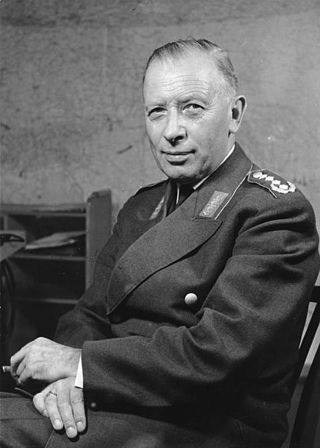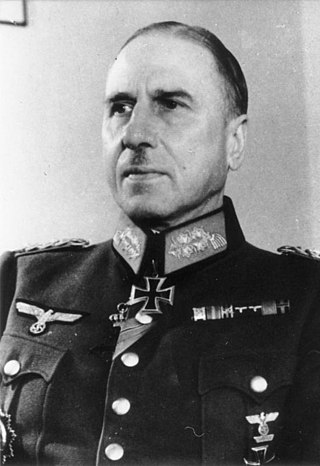Related Research Articles

The ranks and insignia of the Ordnungspolizei were developed in 1936 after the nationalisation of Germany's regular police forces.
The 10th Infantry Division was created in October 1934 under the cover name Wehrgauleitung Regensburg to hide its violation of the Treaty of Versailles. It was renamed the 10th Infantry Division when the establishment of the Wehrmacht was announced publicly in October 1935.

The 3rd Mountain Division was a formation of the German Wehrmacht during World War II. It was created from the Austrian Army's 5th and 7th Divisions following the Anschluss in 1938.

Adolf Bruno Heinrich Ernst Heusinger was a German military officer whose career spanned the German Empire, the Weimar Republic, Nazi Germany, West Germany and NATO. He joined the German Army as a volunteer in 1915 and later became a professional soldier. He served as the Operations Chief within the general staff of the High Command of the German Army in the Wehrmacht from 1938 to 1944. He was then appointed acting Chief of the General Staff for two weeks in 1944 following Kurt Zeitzler's resignation. That year, Heusinger was accused of involvement in the 20 July plot to assassinate Adolf Hitler, but was cleared by the People's Court. Heusinger was later appointed head of the military cartography office when the war ended. He later became a general for West Germany and served as head of the West German military from 1957 to 1961 as well as Chairman of the NATO Military Committee from 1961 to 1964.

The Gau Munich–Upper Bavaria was an administrative division of Nazi Germany in Upper Bavaria from 1933 to 1945. From 1930 to 1933, it was the regional subdivision of the Nazi Party in that area.

General der Panzertruppe was a General of the branch rank of the German Army, introduced in 1935. A General der Panzertruppe was a lieutenant general, above major general (Generalleutnant), commanding a Panzer corps.

General der Gebirgstruppe was a category of German Army three-star, a new example of the traditional German 'General der rank introduced by the Wehrmacht in 1940, comparable to the NATO grade OF-8.

Erick-Oskar Hansen was a German general in the Wehrmacht during World War II. He was a recipient of the Knight's Cross of the Iron Cross of Nazi Germany.

Der Adler was a biweekly Nazi propaganda magazine published by the Scherl Verlag, founded by August Scherl, with the support of the Luftwaffe High Command. From 1939 to 1944, 146 magazine issues were published in total. Each magazine had 24 to 36 pages, but the amount of pages was reduced to 12 when the fall of Nazi Germany was near.
X Army Corps was a corps in the German Army during World War II. It was formed in mid-May 1935 from the Cavalry Division.
XII Army Corps was a corps in the German Army during World War II. It was formed in the Wehrkreis XII recruitment and training district in Wiesbaden in October 1936 and was mobilized before the outbreak of war at the end of August 1939.

The 376th Infantry Division was an infantry division of the German Army during World War II, active from 1942 to 1944 in two separate instances.

The XXVI Army Corps was a Wehrmacht army corps during World War II. It existed from 1939 to 1945. It was also known as Corps Wodrig during the Invasion of Poland.
The LXVII Army Corps, initially known as the LXVII Reserve Corps, was an army corps of the German Wehrmacht during World War II. The corps was formed in September 1942.
The LXXII Army Corps was an army corps of the German Wehrmacht during World War II. The corps was formed in February 1944. Before October 1944, it carried the designation z. b. V., marking it as a corps 'for special deployment'.
The LXXXI Army Corps was an army corps of the German Wehrmacht during World War II. The corps was established in occupied France in 1942 and remained active until 1945.
The LXXXVI Army Corps was an army corps of the German Wehrmacht during World War II. It was formed in 1942 and existed until 1945.
The LXXXVII Army Corps was an army corps of the German Wehrmacht during World War II. It was formed in 1942 and existed until March 1944.
The 270th Infantry Division was an infantry division of the German Heer during World War II.
The 544th Volksgrenadier Division was a Volksgrenadier-type infantry division of the German Wehrmacht during World War II. It was active from July 1944 to May 1945. In the first two months of service, the division was designated 544th Grenadier Division.